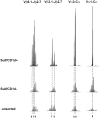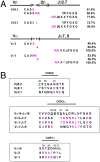Oligoclonality and innate-like features in the TCR repertoire of type II NKT cells reactive to a beta-linked self-glycolipid
- PMID: 20534460
- PMCID: PMC2890761
- DOI: 10.1073/pnas.1000576107
Oligoclonality and innate-like features in the TCR repertoire of type II NKT cells reactive to a beta-linked self-glycolipid
Abstract
TCR-mediated recognition of beta-linked self-glycolipids bound to CD1d is poorly understood. Here, we have characterized the TCR repertoire of a CD1d-restricted type II NKT cell subset reactive to sulfatide involved in the regulation of autoimmunity and antitumor immunity. The sulfatide/CD1d-tetramer(+) cells isolated from naïve mice show an oligoclonal TCR repertoire with predominant usage of the Valpha3/Valpha1-Jalpha7/Jalpha9 and Vbeta8.1/Vbeta3.1-Jbeta2.7 gene segments. The CDR3 regions of both the alpha- and beta-chains are encoded by either germline or nongermline gene segments of limited lengths containing several conserved residues. Presence of dominant clonotypes with limited TCR gene usage for both TCR alpha- and beta-chains in type II NKT cells reflects specific antigen recognition not found in the type I NKT cells but similar to the MHC-restricted T cells. Although potential CD1d-binding tyrosine residues in the CDR2beta region are conserved between most type I and type II NKT TCRs, CDR 1alpha and 3alpha regions differ significantly between the two subsets. Collectively, the TCR repertoire of sulfatide-reactive type II NKT cells exhibits features of both antigen-specific conventional T cells and innate-like cells, and these findings provide important clues to the recognition of beta-linked glycolipids by CD1d-restricted T cells in general.
Conflict of interest statement
The authors declare no conflict of interest.
Figures




Similar articles
-
Vβ2 natural killer T cell antigen receptor-mediated recognition of CD1d-glycolipid antigen.Proc Natl Acad Sci U S A. 2011 Nov 22;108(47):19007-12. doi: 10.1073/pnas.1109066108. Epub 2011 Nov 7. Proc Natl Acad Sci U S A. 2011. PMID: 22065767 Free PMC article.
-
Recognition of lysophosphatidylcholine by type II NKT cells and protection from an inflammatory liver disease.J Immunol. 2014 Nov 1;193(9):4580-9. doi: 10.4049/jimmunol.1400699. Epub 2014 Sep 26. J Immunol. 2014. PMID: 25261475 Free PMC article.
-
Human and mouse type I natural killer T cell antigen receptors exhibit different fine specificities for CD1d-antigen complex.J Biol Chem. 2012 Nov 9;287(46):39139-48. doi: 10.1074/jbc.M112.412320. Epub 2012 Sep 20. J Biol Chem. 2012. PMID: 22995911 Free PMC article.
-
The effect of intracellular trafficking of CD1d on the formation of TCR repertoire of NKT cells.BMB Rep. 2014 May;47(5):241-8. doi: 10.5483/bmbrep.2014.47.5.077. BMB Rep. 2014. PMID: 24755556 Free PMC article. Review.
-
Type II NKT cells: a distinct CD1d-restricted immune regulatory NKT cell subset.Immunogenetics. 2016 Aug;68(8):665-76. doi: 10.1007/s00251-016-0930-1. Epub 2016 Jul 12. Immunogenetics. 2016. PMID: 27405300 Free PMC article. Review.
Cited by
-
Invariant natural killer T cells as sensors and managers of inflammation.Trends Immunol. 2013 Feb;34(2):50-8. doi: 10.1016/j.it.2012.08.009. Epub 2012 Sep 25. Trends Immunol. 2013. PMID: 23017731 Free PMC article. Review.
-
The role of natural killer T cells in liver transplantation.Front Cell Dev Biol. 2024 Jan 5;11:1274361. doi: 10.3389/fcell.2023.1274361. eCollection 2023. Front Cell Dev Biol. 2024. PMID: 38250325 Free PMC article. Review.
-
MAITs and their mates: "Innate-like" behaviors in conventional and unconventional T cells.Clin Exp Immunol. 2023 Jul 5;213(1):1-9. doi: 10.1093/cei/uxad058. Clin Exp Immunol. 2023. PMID: 37256718 Free PMC article.
-
Role for lysosomal phospholipase A2 in iNKT cell-mediated CD1d recognition.Proc Natl Acad Sci U S A. 2013 Mar 26;110(13):5097-102. doi: 10.1073/pnas.1302923110. Epub 2013 Mar 14. Proc Natl Acad Sci U S A. 2013. PMID: 23493550 Free PMC article.
-
Role of sulfatide in normal and pathological cells and tissues.J Lipid Res. 2012 Aug;53(8):1437-50. doi: 10.1194/jlr.R026682. Epub 2012 May 22. J Lipid Res. 2012. PMID: 22619219 Free PMC article. Review.
References
-
- Godfrey DI, Rossjohn J, McCluskey J. The fidelity, occasional promiscuity, and versatility of T cell receptor recognition. Immunity. 2008;28:304–314. - PubMed
-
- Brigl M, Brenner MB. CD1: Antigen presentation and T cell function. Annu Rev Immunol. 2004;22:817–890. - PubMed
-
- Bendelac A, Savage PB, Teyton L. The biology of NKT cells. Annu Rev Immunol. 2007;25:297–336. - PubMed
-
- Kronenberg M, Gapin L. The unconventional lifestyle of NKT cells. Nat Rev Immunol. 2002;2:557–568. - PubMed
-
- Van Kaer L. NKT cells: T lymphocytes with innate effector functions. Curr Opin Immunol. 2007;19:354–364. - PubMed
Publication types
MeSH terms
Substances
Grants and funding
LinkOut - more resources
Full Text Sources
Other Literature Sources
Molecular Biology Databases
Research Materials

